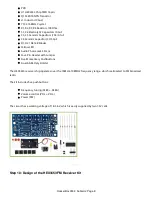
Step 14: Design and Operation of the CCStick
The Arduino ProMicro is based on the ATmega32U4
microcontroller which has a builtin USB interface. This
means that there is no FTDI, PL2303, CH340, or any
other chip acting as an intermediary between your
computer and the Arduino microcontroller.
We suggest rst testing out the Pro Micro without
soldering the pins into place. You can perform the
basic con guration and testing without using the
header pins. Also, delaying soldering on the module
gives one less variable to debug should you run into
any complications.
If you do not have the Arduino IDE installed on your
computer, start by getting downloading the IDE form
arduino.cc. WARNING: Be sure t o select t he
WARNING: Be sure t o select t he
3.3V version under t ools > processor prior
3.3V version under t ools > processor prior
t o programming t he Pro M icro.
t o programming t he Pro M icro. Having this set
for 5V will work once and then the device will appear
to not ever connect to your PC until you follow the
"Reset to Bootloader" instructions in the guide
discussed below, which can be a little tricky.
Sparkfun has a great Pro Micro Hookup Guide. The
Hookup Guide has a detailed overview of the Pro
Micro board and then a section for "Installing:
Windows" and a section for "Installing: Mac & Linux."
Follow the directions in the appropriate version of
those installation instructions in order to get your
Arduino IDE con gured to support the Pro Micro. We
usually start working with an Arduino board by
loading and/or modifying the standard Blink sketch.
However, the Pro Micro does not include the usual
LED on pin 13. Luckily, we can control the RX/TX LEDs
and Sparkfun has provided a neat little sketch to
demonstrate how. This is in the section of the Hookup
Guide entitled, "Example 1: Blinkies!" Verify that you
can compile and download this Blinkies! example
before moving on.
The CC1101 Module and the Arduino ProMicro are inserted onto the silkscreen side of the CCStick PCB. In other
words, the two smaller modules are on the side of the red PCB that has white paint on it and the pins stick out from
the side that has no white paint on it. The white paint is called the PCB silkscreen.
The traces in the red PCB connect the CC1101 Module and Arduino ProMicro like so:
HackerBox 0034: SubGHz: Page 11

































